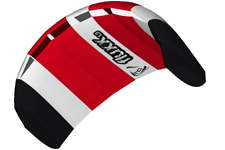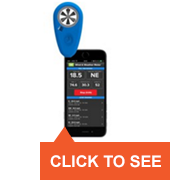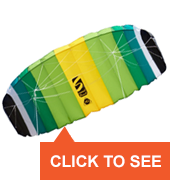Fun University
Guide Center
Skimboarding Guides
Kiteboarding Guides
Stunt Kite Guides
Bike Guides
Trainer Kite Guide
WHAT IS A TRAINER KITE AND WHO NEEDS ONE?
Trainer kites are smaller versions of larger kiteboarding kites and are a fantastic way for beginners to get started without biting off more than they can chew. Typically having fewer complex features than some of the pro-level kites, many trainer kites sport, lean straightforward designs that offer an uncomplicated way to have a really good time!
Simply because trainer kites are smaller versions of their larger brothers doesn’t mean you can’t use them for kiteboarding. While some kites have obvious limitations, a 3.5 meter trainer kite (and sometimes smaller) can get you moving on a skimboard, landboard, snowboard, and even some kite buggies. You’re in for some serious fun, now.
GET THE BEST FOR YOUR BUDGET
One quick way to turn a fun leisure activity into a real bummer is to feel pressured to stock up on gear that is beyond your budget. Your days off shouldn’t send you into debt, but purchasing a quality trainer kite is key. We’ve put together this helpful purchasing guide to give you all the know-how you’ll need to purchase with confidence.
So how much should I spend on a trainer kite?
There is no steadfast rule about the cost of quality when it comes to trainer kites. Depending on your age and weight and how you intend to use it, a $100 price point can give you a decent trainer kite, but $200 can be a game changer. Reading through our product descriptions and comparisons will help you understand the nuances that make each trainer kite unique and why you might favor one over another for your personal use.
KNOW YOUR GOALS

A clear deciding factor in choosing the right trainer kite is to know in advance what you hope to get out of the experience. Are you more interested in casually kickin’ it, or do you have your sights set on a more extreme high-flying experience? Rather than choosing a trainer kite that sounds like it has the coolest features, (let’s be honest – they all have cool features), select one based on the way you want to use it.
We know first hand, that as you become more comfortable with your first trainer kite, your goals may change. The great thing about trainer kites is that they hold their value well, making it easier to afford an upgrade in the future. Perhaps we should insert a disclaimer here that kiteboarding can be an addictive hobby, leading to uncontrollable smiling.
TYPES OF TRAINER KITES
These kites offer flexibility and performance that most trainer kites can’t compete with. If water is not in your immediate future, and your budget allows, these kite should definitely be on your radar. Remember VALUE not PRICE should always be your target when choosing your kite.
OPEN CELL FOIL KITES (Land based)
Open cell kite technology has been around a lot longer than closed cell . Open cell foil kite cells stay inflated by a steady stream of air moving through the kite’s sail. This gives the kite its inflated shape. Without air being trapped, the kite is more sensitive to gusts and will not sit as far back in the wind window. Also the kite will be very fast! This design allows you to quickly setup and fly your kite, but since it absorbs the air all around its sail, it will also absorb water and make a water re-launch impossible. Even if you get it in the air, the water can become trapped making the trainer kite un-flyable.
CLOSED CELL FOILS KITES (WATER FRIENDLY)
Closed cell trainer kites are typically built with air vents on the sails leading edge. These vents trap air in the kite’s sail and give the kite its “inflated shape”. The trapped air in the sail helps the kite sit back further in the wind window, making the kite more docile, and stable to fly. These flying characteristics offer more control, similar to a sheetable power kite, and another reason why closed cells are a great option. Also, since the air is trapped in the trainer kite’s sail, it’s not as sensitive to gusts, meaning the kite will not fall as fast if the wind dies down. The biggest advantage is water re-launchablity. These kites can re-launch off the water with ease, even when re-launching BACKWORDS. This is what makes the HQ Hydra, which is the only closed cell trainer kite, so popular.
2 LINE KITES
2 line trainer kites are the most popular option in kiteboarding today. The value you get from a 2 line trainer kite is hard to match. So, for performance per dollar 2 line trainers are king. You need to know these kites are made of the same materials and more often have the same Sail design as their 3 line brothers. The only true difference is the third, optional line that helps depower and re-launches the kite. This line can be very helpful but it can also go to waste with certain kiteboard flying styles.
3 LINE KITES
3 line trainer kites are very new to the industry. The two most popular brands are HQ Power Kites, and Ozone. Both brands put out an amazing product that any kiteboarding novice would be glad to add to their quiver. Ozone’s flagship 3 line trainer kite is the Ignition and HQ Power Kites actually have two versions; The Rush PRO series and the Hydra. So what makes these kites so special? The third line allows people to launch and re-launch a trainer kite by themselves. This can be a great time saver because once you crash all you can think about is getting back in the air. Kiteboarding and Trainer Kites are that addictive! The third line also helps de-power the trainer kite letting it safely tumble to the ground if the wind gets out of hand.
FIXED BRIDLE 4 LINE (INTER-ADVANCED)
Fixed bridle’s are power kites that offer a truer kiteboarding experience but provide safe parameters for a less experienced flyer to learn on. These kites can be used for training and have a great value, offering a kite, bag, bar, and lines (ready to fly) in a full package. They fly on four-line hybrid system that allows you to fly safely unhooked but also give you the option of a using a harness later in your progression. The only true limitation of these kites is water. With their open cell design, it will not re-launch off the water. These fixed bridle kites are high performers and fly through the wind window with ease. Their quick turning and stable flying make them a great power kite for any skill level. These are kites built to last, and with its power, versatility and beginner-friendly design, you will not need to upgrade soon, unless water is in your future. Below are two of our favorite models.
HQ SCOUT: The HQ Scout power kite has a control bar, sail design that makes this kite stable, able to turn fast and , depower gently. How this power kite differs from a standard trainer is its outstanding power and wind range for snowkiting, landboarding, and buggying.
PRISM TENSOR:
MILD TO WILD: 5 TRAINER KITE RECOMMENDATIONS
1. HQ FLUXX KITE
This is the most affordable trainer kite we offer, but don’t let the price fool you. The Fluxx is a sturdy and reliable product; it flies great and has a great fit and finish for its price range. The HQ Fluxx’s only limitation, is its size. At less than 2 meters square sail area, it will not generate the pull that bigger power kites are famous for having. On that same note you don’t have to worry about being overpowered either. The Fluxx comes in three sizes 1.3m,1.8m, and 2.2 meters. Please note this refers to the wingspan and not the kite sail area. If you plan to get a bigger kite and are worried about damaging it, this all makes a great companion for your quiver.
2. PRISM TANTRUM KITE
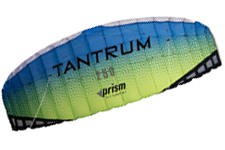
The Tantrum is brand new in the Prism kite lineup. They come in two models, 220 and 250. The 220 the model number refers to the wingspan on the kite’s sail area. So the 220 has wingspan of 2.2 meters. The quality and performance of these trainer kites are great at their price point. They are designed with 2 lines enabling them to fly with a bar in a very simple configuration. The Tantrum isn’t a power house but it will teach you how to safely maneuver in the wind, and you’ll learn the how to fly basics before your first Kiteboarding lesson.
3. HQ RUSH V PRO TRAINER KITE
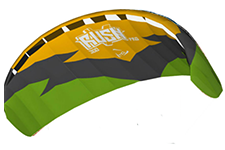
The Rush V PRO is an amazing 3-line trainer kite, second only to the Hydra. You get all the benefits from the regular Rush V but, you get to enjoy the addition of a third line. The third line makes re-launching and depowering the kite a breeze. It can make a two person flying setup a one-man band. The Rush PRO generates tremendous power and demonstrates superb functionality, compared with other trainer kites. I recommend the Rush PRO to anyone needing a powerful trainer for landboarding, buggying, snowkiting, or general power kiting. The only weakness of this flyer is being a land based kite. If you want to fly in the water, I recommend checking out the Hydra.
4. HQ HYDRA II TRAINER KITE
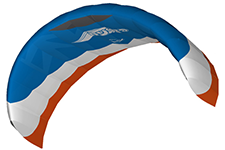
Last but not least…the King, the Best, and the Mailman of trainer kites, we present to you…the Hydra! No rain, sleet or snow will stop this trainer kite from getting its job done! It’s the only trainer kite on the market with a unique, closed cell design, allowing it to be used on any terrain and relaunched off the water. This 3-line HQ Hydra is the only trainer kite that is used with surfboards, SUPs, skateboards, landboards, snowboards, Skis, Kayaks, and more. The price is higher than most trainers, but it reflects the quality, versatility and all around awesomeness that is the HQ HYDRA II.
5. PRISM TENSOR POWER KITE
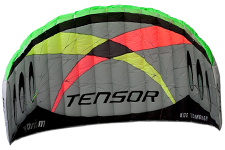
The sleek line of an Prism Tensor kite line is a vision to behold. The Tensor is not really a trainer kite but a true power kite. It sports 4-lines and can be flown with bar or handles. Included comes a convertible bar / handle system which is unique the Tensor. You may be asking yourself why is this kite being recommended as a trainer? Well the beauty of the design of a fixed bridle system is you can fly safely unhooked (without harness), and as you progress add a harness into the mix. This allows you to do sports such as buggying, landboarding, and snowkiting in wide wind range with plenty of power. Also you can make adjustments to the bridle for optimum performance. This kite is great for flyers that want more than a trainer kite but also want the safety of one.
TRAINER KITE COMPARISON CHART
| NAME | SIZE | DEPOWER | WIND RANGE | PULL | TERRAIN |
| HQ Fluxx | .60 - 1.33 Meters Sq. | None | 5-24mph | Low - Medium | Land |
| Prism Tantrum | 1.27 - 1.76 Meters Sq. | None | 4-25mph | Medium | Land |
| HQ Rush V | 1.4 - 2.8 Meters Sq. | None | 4-25mph | Medium to High | Land |
| Sensei / Crazyfly Rookie | 2 - 1.76 Meters Sq. | None | 5-26mph | Medium | Land |
| HQ Rush V PRO | 2 - 3.5 Meters Sq. | Full | 5-28mph | Medium to Very High | Land |
| Ozone Ignition | 1 - 2.9 Meters Sq. | Full | 4-23mph | Medium to Very High | Land |
| HQ Hydra II | 2.6 - 4.5 Meters Sq. | Full | 4-28mph | Medium to Highest | Water and Land |
| Prism Tensor | 3.1 Sq. - 5M Sq. | Full | 4- 38mph | High to Highest | Land |
| HQ Scout | 3 - 5 Meters Sq. | Full | 4-38mph | High to Highest | Land |
| Ozone Uno | 2.5 - 4 Meters Sq. | Full | NA | High to Highest | Water and Land |
SIZE: This is the area of the kite in square meters.
DEPOWER: This is the ability of the trainer kite to power itself (kill power) and it can be used to relaunch the kite. Very handy option, and can eliminate the need for a second person to help.
WIND RANGE: This is the safe wind speed range to fly to the kite in.
TERRAIN: This is the recommended area to fly, a land kite, will not relaunch off water and can take hours to fully dry out.
PULL: This is the power of kite it generates in its optimum wind range.
Low - Does not generate the heel-dragging pull most power kite enthusiasts want. You’ll learn basic flying and kite skills, while getting some decent tugs. The power level will be a fast but docile flyer.
Medium - Generates a nice firm pull. In enough wind a 2-meter trainer kite will pull most adults around. Great for casual flyers who are seeking a little pull and some great exercise.
High - These trainer kites will pull and drag you through sand. A 3-meter trainer kite is a great all around size for most flyers.
Very High – This will give some really good pull without getting to crazy or big.
Highest - This is when trainer kites show there highest potential. This power level allows kiters to train and practice into many different kite sports (ie. Snowkiting, Landboarding, Kitesurfing, Kiteboarding, and Buggies). A Rush 350 Pro will give you the power to get on a landboard and experience a bit of what you see online in videos like this. A Hydra 420 trainer kite will give you the opportunity to get in the water to practice body drags, plus board and trainer kite manipulations. A HQ Scout or Prism Tensor will allow you to do some real kite sports but a lot safe then a full depower kite.
WHAT ADDITIONAL EQUIPMENT DO I NEED?
Kiteboarding Instructional DVDs
When getting into kiteboarding nothing can complement a trainer kite like an Instructional DVD. Even if you’re not ready for a trainer kite, or still debating on getting into the sport, this will be the best $ you ever spend. It will give you a strong foundation in understanding the sport, and help you get the most out of your lessons. The two most popular options are the Way to Fly and Progression Kiteboarding DVD series.
Windmeter (Anemometer)
A Windmeter, also known as an Anemometer, is a must-have tool used by kiters everywhere to locate wind direction and speed. Some models even test the water temperature and barometric pressure. Having location-specific weather information is vital to knowing when you should attempt to fly your kite or not, and can make the difference between having a dud of a day or the time of your life. Handhelds were very popular now smart phone models with or without Bluetooth are the rage. Best part is all the information is store on your phone. Some models have dual purpose for long range shooting or ballistics.
Small Basic 2 Line Kite
A small 2-line kite can be cheap insurance from damage to an expensive trainer. These kites are open cell foil sport kites with two flying lines. The size of these kites is usually around .5 meters squared. They usually don’t have a bar but fly by the same dynamics as their larger siblings. Also they can be great fun for young flyers or keep crazy uncle Bob from blowing out cells in your brand new Hydra.
Landboard
Landboards are great fun and teach your body the necessary skill of staying on your feet while kiting. Not to mention, they are more affordable then kiteboards and buggies. Even a seasoned skater will receive a fun challenge trying new tricks. Don’t worry if you never skated or surfed, and are worried you can’t learn to kite landboard just as easy as Tony Hawk! I have seen with my own two eyes older individuals with bad knees and no boarding experience pick up landboarding like a duck to water. How, you ask? They practice and take things slow.
YOUR KITE JOURNEY STARTS NOW
Now that you have read our trainer kite guide, we hope we’ve given you all the information necessary to make the best purchase for your needs. Below is a list of frequently asked questions that may help you further. Remember, kiting doesn’t have to be a wallet-draining experience. Use this guide to help you get the most bang for as many bucks as you are comfortable spending (and no more!). A lot of fun, great exercise and learning can come from even the most modest of kites.
Shadeonme offers the top trainer kites at the lowest price structures possible. Our mission is to educate our consumers so they can choose the best products for their needs, and to deliver a quality product every time. The ShadeOnMe family just asks you to enjoy your experience and if you have any questions please Contact Us!
FAQ
WHY DO I NEED A TRAINER KITE?
Trainer kites are the only power kites that are safe enough for a Novice flyer. PLEASE NOTE: Any Power Kite can be dangerous so think about safety first, and always take precautions before using.
WHAT IS THE MOST POPULAR TRAINER KITE?
There never is just one kite for everybody but read above our FIVE RECOMMENDED TRAINER KITES to find our most popular and recommend options.
WHAT DOES 2M, 3M, 350 MEAN?
Trainer kite models and sizes can be very confusing for even the most seasoned of kiters. Usually a 2m means that the flat area of the kite is 2 square meters. Then some manufacturers round up, or use wing span. To be sure of the size you are getting read above our TRAINER KITE COMPARISION CHART.
HOW LONG BEFORE I AM READY FOR A TRUE SHEETABLE DE-POWER KITE?
This depends on you! Your knowledge, confidence (not cockiness, cockiness gets kiters hurt or worse) and skill progression will be the deciding factors. For most people, logging lots of hours on your trainer kite, taking several comprehensive lessons from a certified professional, watching our training DVDs, and continually taking safety precautions will prepare you for the next step up.
WHY SHOULD I BUY FROM YOU?
My favorite question! It’s your money and I can make a big spiel of why we are so great and everyone else is not, but our products, prices and reputation for excellent customer service speak for themselves. First ask yourself: Who’s guide am I reading? Who has the best value? Who is not trying to upsell me? Long story short - we do not just sell products, we endorse them and if we do not have the best price or value email or call us.
CAN I KITEBOARD / KITESURF WITH A TRAINER KITE?
The fast answer is no you can’t, because the power needed to generate a deep water start is tremendous. Like most rules there is an exception - the HQ Hydra ll 420 is a huge kite with tons of power, and loves the water. This is only trainer kite that can re-launch backwards on the water. While it has been known to deep water start an individual, I do not recommend it. Just because you can potentially do it, doesn’t mean you should.
ARE THESE KITES HARD TO FLY?
Most trainer kites are built so absolute beginners can learn to fly easily and safely. The biggest mistake new kiters make is not learning everything they can about using their kite and how to fly in different wind conditions. That’s why I highly recommend The Progression Beginner or Way to Fly DVD to get you started in the right direction.
ARE THEY DURABLE?
Quality trainer kites are made to last. But like anything, misuse and accidents happen. Taking a 1.4 Meter kite in 60MPH winds is going to destroy the kite. Crashing a Rush 350 Pro to ground at full speed is going to burst a cell. In the event you have any problems with your kite, contact us and we will find a solution for you.
CAN I FLY BY MYSELF?
Some people fly trainer kites by themselves (with a depower line) with no problems and some need more assistance. It depends on the experience, comfort level as a flyer. But seriously, it’s more fun with friends and family, so bring the whole gang if you can.
WHAT HAPPENS WHEN MY TRAINER KITE CRASHES IN THE WATER?
If you have a HQ Hydra just launch it back in the air and smile. If not, no problem - just shake it out, let it air dry and it will be fine.
2 Line vs 3 Line Trainer Kites?
This is a hot debate in kiteboarding. Many kiteboarding instructors and retailers argue back and forth about which is better. I take a stance of what are you going to use the kite for? Whats your budget and end goal? Do you have someone to help you to fly it? So which is the better trainer kite setup? The ANSWER is…..Honestly it all comes down to the person buying the kite. Your “Mission Drives the Gear” which means your needs are going to determine which trainer kite would better suit you. Buying a Hydra 420 when you just want something to fly with the family and teach your children, is not the best choice. If you want a kite that lets you depower, relaunch it by yourself and use it for more of a sport then a learning tool go with the 3 or 4 line.
OPEN CELL VS CLOSED CELL KITE FOR TRAINING?
Open cell trainer kites are not better than closed cell trainer kites; what you want all depends on your trainer kite’s application. Remember our motto at Shadeonme “Mission Drives the Gear.” This simply means your best gear choice depends on how you are going to use it. If you plan to use your kite in the water, the closed cell design will be a better choice overall. If you want the best bang for your buck, open cell is the way to go.
 Loading... Please wait...
Loading... Please wait...

